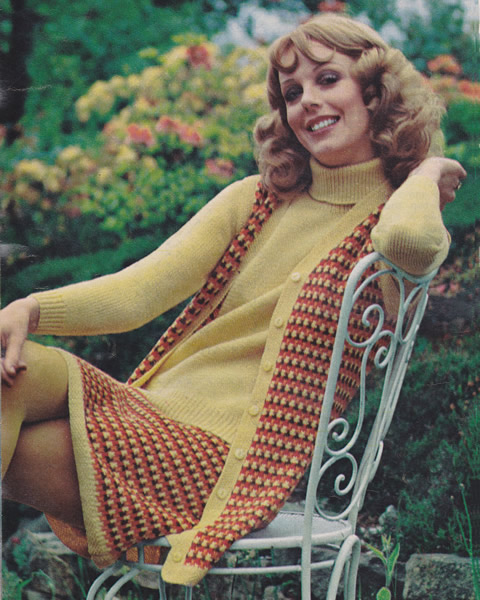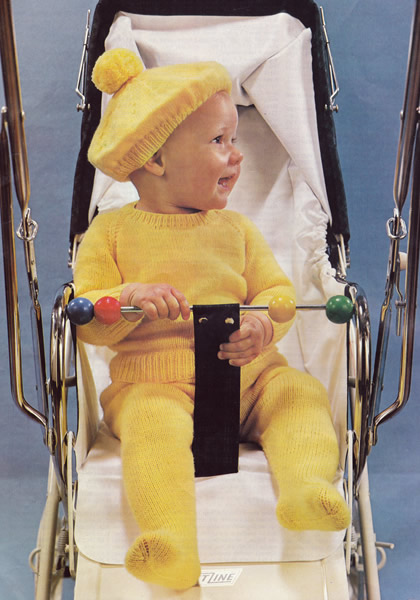Instructions
Jumper Back
★ Using size 12 (2¾mm) needles, cast on 72 (76,
80, 84)
stitches, and work in k1/p1 rib for 1½ inches ending with a wrong
side row.
Change to size 10 (3¼mm) needles and stocking stitch (1 row knit,
1 row purl).
Continue until work measures 5½ (6,
6½, 7)
inches from the beginning, ending with a purl row.
Shape Raglan Armholes by casting off 3 stitches at the beginning
of the next 2 rows.
Next row: k2, p2tog, knit to the last
4 stitches, p2tog, k2.
Next row: purl.
Repeat the last 2 rows ★ until 26 (28,
28, 30)
stitches remain, ending with a wrong side row.
Leave these stitches on a spare needle.
Jumper Front
Follow instructions for Back from ★ to ★, until 42 (44,
44, 46)
stitches remain, ending with a wrong side row.
Next row: k2, p2tog , k10 stitches
and turn, leaving remaining stitches on a spare needle.
Still decreasing at the armhole edge as before, at the same time, decrease
1 stitch at the neck edge on every following alternate row until 5 stitches
remain.
Keeping the neck edge straight, continue to decrease at the armhole edge
until 2 stitches remain, working the decreases at the outer armhole
edge when they can no longer be worked inside the border of 2 stitches.
Work 1 row; k2tog, and fasten off.
Slip the centre 14 (16, 16,
18) stitches onto a spare needle.
Join in the yarn at the neck edge to the remaining stitches; knit to the
last 4 stitches, p2tog , k2.
Complete to match the first side of neck.
Jumper Sleeves
Using size 12 needles, cast on 36 (38,
40, 42)
stitches and work in k1/ p1 rib for 1½ inches, ending with a wrong
side row.
Change to size 10 needles and stocking stitch.
Increase 1 stitch at each end of the 3rd and every following 4th row until
there are 52 (56, 60,
64) stitches on the needle.
Continue without further shaping until work measures 5½ (6,
6½, 7)
inches from the beginning, ending with a purl row.
Shape Raglan Top by casting off 3 stitches at the beginning of
the next 2 rows.
Next row: k2, p2tog, knit to the last
4 stitches, p2tog, k2.
Next row: purl.
Repeat the last 2 rows until 6 (8,
8, 10)
stitches remain, ending with a wrong side row.
Leave these stitches on a safety pin.
Jumper Neckband
Using a flat stitch, join raglan seams, leaving left back raglan seam
open. With the right side of the work facing and using size 12 needles,
knit across the 6 (8, 8,
10) stitches on the top of the Left
Sleeve;
pick up and knit 12 stitches down the left side of the neck; knit across
the 14 (16, 16,
18) stitches at the centre; pick up
and knit 12 stitches up the right side of the neck; knit across the 6
(8, 8,
10) stitches on top of the Right Sleeve,
and the 26 (28, 28,
30) stitches on the back neck.
[76 (84, 84,
92) sts.]
Work in k1/p1 rib for ¾ inch.
Cast off in rib.
Leggings - right leg
★ Using size 12 needles, cast on 72 (76,
80, 84)
stitches.
Work 4 rows in k1/p1 rib.
Next row: Rib 4, *
yfwd., k2tog, rib 2. Repeat from *
to end.
Work 3 rows in rib.
Change to size 10 needles and work as follows. ★
Shape Back
1st row: knit 16 (18,
20, 22)
stitches and turn.
2nd row: purl to end.
3rd row: knit 31 (33,
35, 37)
stitches and turn.
4th row: purl to end.
5th row: knit 46 (48,
50, 52)
stitches and turn.
6th row: purl to end.
7th row: knit 61 (63,
65, 67)
stitches and turn.
8th row: purl to end.
★★ Continue in stocking stitch, working across all stitches
for 28 (32, 32,
34) rows.
Increase 1 stitch at each end of the next and every following 5th row
until there are 88 (92, 96,
100) stitches on the needle, then
increase 1 stitch at each end of the next 2 rows. [92 (96,
100, 104)
sts]
Commence Leg Shaping by casting off 2 stitches at the beginning
of the next 2 rows.
Decrease 1 stitch at each end of the next and every following alternate
row until 66 (72, 76,
80) stitches remain; then decrease
1 stitch at each end of every following 3rd row until 38 (38,
42, 42)
stitches remain.
Continue on these stitches until work measures 16½ (17¼,
17¾, 18½)
inches at the longest (back) edge, ending with a purl row. ★★
Shape Foot
Next row: knit 31 (31,
34, 34)
stitches and turn.
Next row: purl 13 (13,
14, 14)
stitches and turn.
Work on the centre 13 (13, 14,
14) stitches for 1¾ (2,
2, 2¼)
inches, ending with a purl row. Break off yarn and join it to the inner
edge of the 18 (18, 20,
20) stitches already knitted, pick
up and knit 13 (15, 15,
17) stitches along the first side
of the instep; knit across the 13 (13,
14, 14)
toe stitches, and then knit 13 (15,
15, 17)
stitches along the other side of the instep; then knit the remaining 7
(7, 8,
8) stitches.
[ 64 (68, 72,
76) sts]
Commencing with a purl row, work 7 rows in stocking stitch.
1st row: k3, sl1, k1, psso, k1 (1,
2, 2),
k2tog, k27 (29, 30,
32), sl1, k1, psso, k1 (1,
2, 2)
k2tog, k24 (26, 27,
29).
2nd and every alternate row: purl.
3rd row: k2, sl1, k1, psso, k1 (1,
2, 2),
k2tog, k.25 (27, 28,
30), sl1, k1, psso, k1 (1,
2, 2)
k2tog, k23 (25, 26,
28).
5th row: k1, sl1, k1, psso, k1 (1,
2, 2),
k2tog, k23 (25, 26,
28), sl1, k1, psso, k1 (1,
2, 2),
k2tog, k22 (24, 25,
27).
6th row: purl.
Cast off.
Leggings - left leg
Work as for Right Leg from ★ to ★ .
Shape Back
1st row: purl 16 (18,
20, 22)
stitches and turn.
2nd row: knit to end.
3rd row: purl 31 (33,
35, 37)
stitches and turn.
4th row: knit to end.
5th row: purl 46 (48,
50, 52)
stitches and turn.
6th row: knit to end.
7th row: purl 61 (63,
65, 67)
stitches and turn.
8th row: knit to end.
Commencing with a purl row, follow the instructions for the Right Leg
from ★★ to ★★.
Shape Foot
Next row: knit 20 (20,
22, 22)
stitches and turn.
Next row: purl 13 (13,
14, 14)
stitches and turn.
Work on the centre 13 (13, 14,
14) stitches for 1¾ (2,
2, 2¼)
inches, ending with a purl row. Break off yarn and join it to the inner
edge of the 7 (7, 8,
8) stitches already knitted, pick
up and knit 13 (15, 15,
17) stitches along the first side
of the instep; knit across the 13 (13,
14, 14)
toe stitches, and then pick up and knit 13 (15,
15, 17)
stitches along the other side of the instep; then knit the remaining 18
(18, 20,
20) stitches.
[ 64 (68, 72,
76) sts]
Commencing with a purl row, work 7 rows in stocking stitch.
1st row: k24 (26,
27, 29);
sl1, k1, psso, k1 (1, 2,
2), k2tog, k27 (29,
30, 32),
sl1, k1, psso, k1 (1, 2,
2) k2tog, k3.
2nd and every alternate row: purl.
3rd row: k23 (25,
26, 28);
sl1, k1, psso, k1 (1, 2,
2), k2tog, k.25 (27,
28, 30),
sl1, k1, psso, k1 (1, 2,
2) k2tog, k2.
5th row: k22 (24,
25, 27);
sl1, k1, psso, k1 (1, 2,
2), k2tog, k23 (25,
26, 28),
sl1, k1, psso, k1 (1, 2,
2), k2tog, k1.
6th row: purl.
Cast off.
Beret
Using size 12 needles, cast on 132 (132,
136, 136)
stitches and work 9 rows in k1/p1 rib.
Next row (increase row): rib 7 (7,
9, 9).
* work twice into the next stitch,
rib 2; repeat from * to the last 8
(8, 10,
10) stitches; work twice into the
next stitch, rib 7 (7, 9,
9).
[172 (172, 176,
176) sts]
Change to size 10 needles and stocking stitch.
Work 20 (20, 24,
24) rows.
Shape Crown
1st decrease row: k8 (8,
6, 6),
* k2tog, k9 (9,
7, 7);
repeat from * to last 10 (10,
8, 8)
stitches; k2tog, k8 (8, 6,
6).
[157 sts]
Work 5 rows straight.
2nd decrease row: *
k9; k3tog; repeat from * to last stitch,
k1.
[131 sts]
Work 5 rows straight.
3rd decrease row: *
k7; k3tog; repeat from * to last stitch,
k1.
[105 sts]
Work 5 rows straight.
4th decrease row: *
k5; k3tog; repeat from * to last stitch,
k1.
[79 sts]
Work 5 rows straight.
5th decrease row: *
k3; k3tog; repeat from * to last stitch,
k1.
[53 sts]
Work 5 rows straight.
6th decrease row: *
k1; k3tog; repeat from * to last stitch,
k1.
[27 sts]
Work 3 rows straight.
Next row: k3tog all along the row.
[9 sts]
Break off yarn, thread through remaining stitches, draw up and fasten
off securely.
To Make Up
Jumper
Sew in zip to left back raglan seam, then join the remainder of the seam.
Using a back stitch, join side and sleeve seams.
Leggings
Using a back stitch, join the back, front, leg and foot seams.
Thread elastic through eyelet holes at the waist.
Beret
Using a flat stitch, join the seam.
Sew a pompon to the top of the crown.
To make a pompon, cut wool into 3 inch lengths; tie securely in the centre;
fluff out and trim to shape.
|






